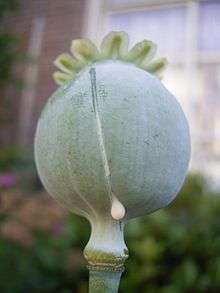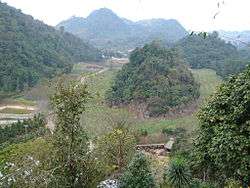Royal Project Foundation
| Abbreviation | RPF |
|---|---|
| Formation | 1969 |
| Type | Non-profit Organisation |
| Purpose | Improve the quality of life of the hill-tribe people and to decrease the opium-growing in the highland. |
| Headquarters | Chiang Mai, Thailand |
| Website |
www |
The Royal Project Foundation is a Thai non-profit organisation based in north Thailand. It was founded by King Bhumibol Adulyadej as an umbrella organization for his charitable initiatives and research.[1][2][3] The focus of the foundation is to improve the quality of life of hill tribes.[2][4][5] Ancillary goals are to reduce opium-growing and to revive forests and water resources.[4] The Royal Project Foundation is considered one of the first and most successful projects for opium production elimination.[2][5] It was awarded The Ramon Magsaysay Award for International Understanding in 1988.[6]
History


The project began in 1969, when King Bhumibol Adulyadej visited an opium-growing hill tribe village in Doi Pui.[3] During his visit, the king learned that a local peach could provide income for the hill tribe people.[1] He found that the Doi Put Development Centre, Faculty of Agriculture, Kasetsart University, was testing and developing a suitable type of peach for the environment. It could provide higher incomes to the local people than opium-growing.[3] He instructed the Crown Property Bureau to give 200,000 baht to the project.[1][3]
After the first few years, the project received support from international agencies. In 1972, the UN realised the importance of alternative agriculture to replace opium-growing. The UN/Thai Program for Drug Abuse Control was begun.[1] Between 1973 and 1984, USDA-ARS also supported the project by giving money to the project for research and development to find the best and most suitable fruits and vegetables for the highlands.[1][3]
In 1992, the royal project changed its name to the Royal Project Foundation and became a public organisation for the people's benefit permanently.[1][2][3]
Purpose

The goals of the Royal Project Foundation are:
- To help hill tribes achieve a better life
- To prevent the destruction of natural resources
- To stop opium growing
- To care for make best use of the soil in each area
- To increase the amount of alternative agriculture for the benefit of Thailand's economy
Development centres
Today, the Royal Project Foundation has 38 development centres spread across five provinces in northern Thailand: Chiang Mai Province, Chiang Rai Province, Mae Hong Son Province, Lamphun Provinceand Phayao Province.[7] The development centres are not only for researching and developing projects for the foundation, but some have become tourist destinations.[3][8]

In Chiang Mai, there are 27 development centres which include three Royal Agriculture Stations: Doi Ang Khang, Doi Inthanon, and Pangda; one research station, Mae-Lod; and 23 development centres: Ka Noi, Khun Phae, Khun Wang, Teen Tok, Tung Rao, Tung Roeng, Tung Luang, Nong Khieo, Nong Hoi,[9] Pa Mieng, Pang Ung, Mon Ngo, Mok Cham, Mae Tho, Mae The Nuier, Mae Phae, Mae Sa Pok, Mae Sa Mai, Mae Hae, Wat Chan, Haui Luk, Haui Siao, and Huai Som Poi.[3][7][8][10]
In Chiang Rai, There are three development centres: Pha Tung, Mae Poon Luang, and Sa Ngo.[3][7][8]
In Mae Hong Son, there are six centres: Mae La Noi, Mae Sariang, Huai Nam Khun, Huai Nam Rin, Huai Pong, and Huai Lang.[3][7][8]
In Lamphun, there is one development centre, Pha Bath Huay Tom.[3][7][8]
In Phayao, there is one development centre, Pang Cha.[3][7][8]
Projects
Projects are changing, developing and adapting to the issues and things that need to be solved or improved for the highlands environment.[11] All the projects are made to achieve the main purposes that the Royal Project Foundation has and to improve the quality of life of highland communities.[11]
The Marketing Project is research on the cost and profitability of the Royal Project's fruits and vegetables. This project also studies the customer behaviour in choosing and buying the products. This is to come up with the best marketing plan for selling the project's produce.[11]
The environmental conservation project researches the highland environment, forests, water, and soil, to optimize sustainable yields.[11]
The Royal Project Culinary
Although the Royal Project Foundations were founded to solve problems of deforestation, opium and poverty, many have since become tourist attractions in Thailand.[12] There are a diverse range of things for tourists to do, including: learning how to make a unique local dish, releasing fish into the seas, feeding cattle or teaching the village children before spending a night in the house of a local family.[13]
In end 2016, the Tourism Authority of Thailand held an "Amazing Dream Journey" contest, where winners had the chance to have a free trip to Thailand and sample dishes by a Thai celebrity chef (Chumpol Jangprai),[14] using Royal Project food products.[15]
At the "KHAO" restaurant at Chiang Mai's Four Seasons hotel resort, chefs sources certain ingredients exclusively from farmers who work with the Royal Project, with a focus on preserving local knowledge on agriculture and helping communities become self-sufficient.[16]
Royal Project winter fruit also featured at the ASEAN Tourism Forum held in Chiang Mai in January 2018.[17]
See also
References
- 1 2 3 4 5 6 "The Royal Project Foundation's Background", Retrieved 2017-10-15.
- 1 2 3 4 "The Royal Project Foundation", Thailand Sustainable Development Foundation (2016), Retrieved 2017-10-15.
- 1 2 3 4 5 6 7 8 9 10 11 12 "38 เส้นทางความสุข 38 โครงการหลวง", อมรา ศิริพงษ์, ชัยเนตร ชนกคุณ, ชุติมา ทองดี, ดิลก หาญผล, รอรบ โกมลฐิติ (October 2011), Retrieved 2017-10-15.
- 1 2 "The Royal Project Foundation's Purposes", Retrieved 2017-10-15.
- 1 2 "Vegetable Supply Chain Management: The Royal Project Foundation in Thailand", N. Jayamangkala, Retrieved 2017-10-15.
- ↑ "The Ramon Magsaysay Award Foundation", Retrieved 2017-11-13.
- 1 2 3 4 5 6 "The Royal Project Foundation's Development Centres", Retrieved 2017-10-15.
- 1 2 3 4 5 6 " 38 โครงการหลวง ตามร้อยเท้าพ่อ", (3 November 2016), Retrieved 2017-10-15.
- ↑ "Take a walk in the hills and discover the uniquely Thai Royal Project at Nong Hoi". TAT Newsroom. 2017-10-20. Retrieved 2018-03-01.
- ↑ "The Royal Projects in Thailand", Thai Travel News (11 December 2016), Retrieved 2017-10-15.
- 1 2 3 4 "The Royal Project Foundation's Projects", Retrieved 2017-10-15.
- ↑ "Amazingstories Thailand trip planner,Thailand travel guide,Amazingstories,Amazing Dream Journey,Dream Journey,Journey,Amazing". Amazingstories Thailand trip planner,Thailand travel guide,Amazingstories,Amazing Dream Journey,Dream Journey,Journey,Amazing (in Thai). Retrieved 2018-03-01.
- ↑ "Make a real connection to Thailand through Royal Projects". TAT Newsroom. 2017-10-20. Retrieved 2018-03-01.
- ↑ "Chumpol Jangprai Profile | Thailand Tatler". Thailand Tatler. Retrieved 2018-03-01.
- ↑ "Amazingstories Thailand trip planner,Thailand travel guide,Amazingstories,Amazing Dream Journey,Dream Journey,Journey,Amazing". Amazingstories Thailand trip planner,Thailand travel guide,Amazingstories,Amazing Dream Journey,Dream Journey,Journey,Amazing (in Thai). Retrieved 2018-03-01.
- ↑ "Chiang Mai Restaurant Hosts Thai Culinary Event at Four Seasons". Four Seasons Press Room. Retrieved 2018-03-01.
- ↑ "Ten Talented Thai Chefs Showcase Thai Gastronomy at ATF 2018 Gala Opening - TAT Newsroom". TAT Newsroom. 2018-01-24. Retrieved 2018-03-01.